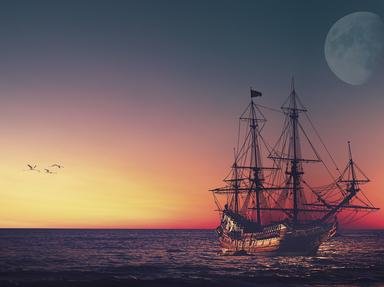Quiz Answer Key and Fun Facts
1. Zheng He lived at the perfect time in Chinese history to be suited for overseas exploration. Born in 1371, he was only 3 years younger than what long-spanning dynasty that would last until the mid-1600s?
2. In 1405, Admiral Zheng set off on his first voyage. Wanting to impress (and scare) the local populations Zheng would come across, his fleet was outfitted with a few more ships than Spain would give Christopher Columbus in 1492. How many ships and men were at Zheng's disposal?
3. When Columbus set off from Spain, his largest ship, the Santa Maria, was measured anywhere from 70-87 feet long. Admiral Zheng wouldn't be caught dead on a boat that size, and instead paraded around the seas in massive treasure ships, which were roughly the size of what modern structures?
4. On Zheng's first voyage, he went to Siam, Malacca, Java, and Champa before sailing west across the Western (Indian) Ocean. The fleet navigated around Ceylon to the west coast of India. What city marked the farthest spot he visited on this first trip?
5. The second voyage was significantly shortened when one of the kingdoms he had previously visited decided to seize the fleet. Zheng led his massive army to eventual victory over the attackers in a land war with what state?
6. Basking in glory of his triumphant victory, Zheng could accept no less than a major tribute from the attacking nation to make up for the grievances it caused. Zheng captured exactly what he wanted from King Alagonakkara and took it back to China with him. What was it that Zheng took?
7. Though the third voyage did little of interest, Zheng's fourth voyage moved much farther to the west. The fleet entered into the Middle East and later reached the eastern shore of Africa. Zheng also travelled into the Red Sea and reached which holy Islamic site?
8. Upon arrival at the Islamic site, Zheng could not help but enjoy his surroundings. He had arrived during the annual hajj, a religious pilgrimage that every able-bodied Muslim must take up at some point in their lives. Why did this hold a special significance for Zheng?
9. Zheng's fifth voyage revisited the Middle East and Africa, and by all accounts so did his sixth. However, in 2003 Gavin Menzies claimed that it was on this sixth voyage Zheng decided to take a much different route in a highly publicized book. What did Menzies claim Zheng did in 1421?
10. Several problems exist with Menzies' theory on Zheng's accomplishments in 1421. Which of the following is NOT a reason that historians have dismissed his claims as simple historical fiction?
11. In 1424, Emperor Yongle died and his son, Hongxi, took over. Hongxi decided to stop Zheng's voyages and did not allow the fleet to leave during his reign. This policy lasted as long as the Emperor held power, which was how long?
12. Zheng's final voyage commenced after the longest gap between any two voyages. In 1431, he left to visit the Southeast Asia, the Middle East, and Africa once again, but the most notable event happened on the return trip back to China. What happened?
13. The year of Zheng's first voyage coincided with the lifting of a shipping ban that was later reinstated by the Ming Dynasty in 1550, before being repealed again soon after. The Qing Dynasty re-initiated the policy again in 1647, basically ending Chinese naval power until the modern era. What was this policy called?
14. One sad outcome of the shipping ban was the decision made by later Ming leaders in reference to Zheng's voyages over 100 years before. The inward turn to focus on local threats also led the Emperor to decide to help his people forget their former glory. What extreme step did China take?
15. In 2005, the People's Republic of China fully embraced Zheng's accomplishments and decided to institute a holiday in his honor. It was first celebrated as the 600th anniversary celebration of Zheng's first voyage in 1405. What day of the year is Maritime Day celebrated in China?
Source: Author
illiniman14
This quiz was reviewed by FunTrivia editor
Snowman before going online.
Any errors found in FunTrivia content are routinely corrected through our feedback system.
